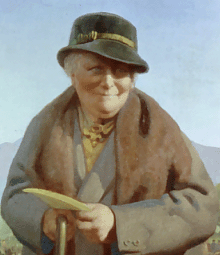Beatrix Potter
(1866-1943)
 Helen Beatrix Potter was born to a to a typical Victorian middle class family in Kensington, London in 1866. Her childhood was isolated, she was educated by a governess and had little contact with other children.
Her younger brother, Bertram, was rarely at home; as he was sent to boarding school.
Helen Beatrix Potter was born to a to a typical Victorian middle class family in Kensington, London in 1866. Her childhood was isolated, she was educated by a governess and had little contact with other children.
Her younger brother, Bertram, was rarely at home; as he was sent to boarding school.
The young Beatrix kept many pets as companions, she kept frogs and newts and even had a pet bat. She also had two rabbits, which she studied closely and made drawings of.
Her father, Rupert Potter, a barrister, spent much of his time at Gentlemen's clubs. Both her parents lived on incomes derived through inheritance.
When Beatrix was sixteen her wealthy parents rented Wray Castle on the west bank of Lake Windermere for a family holiday in the Lake District. Beatrix was sixteen when they first stayed here. Thus began a long love affair between Beatrix Potter and the Lakeland scenery that so enchanted and enthralled her.
Further family holidays were to be spent in the Lake District, she stayed at Holehird, near Windermere, and at Lingholm on the banks of Derwent Water. The shores and islands of the Derwentwater were later to feature highly in the 'Tale of Squirrel Nutkin'. Beatrix delighted in watching red squirrels in the woods and made many sketches of the landscape and the wildlife, which she made into greetings cards on her return to London.
She recieved encouragement to write a book from her friend Hardwicke Rawnsley, vicar of Wray Church and one of the founders of the National Trust, but she struggled to find a publisher until it was accepted when she was 36, when her her famous 'Tale of Peter Rabbit' was eventually published in 1902. The book sold thousands of copies and was to become one of the best selling children's stories ever to be written.
Beatrix Potter first set eyes on the seventeenth century farmhouse, Hill Top Farm, at Near Sawrey in 1896. Using the proceeds from her books, she was able to purchase the house in 1905.
Through transactions in purchasing property in the area, Beatrix met her future husband, William Heelis, a Hawkshead solicitor, the couple were married in 1913, when Beatrix was aged 47, no children resulted from the marriage. Following her marriage she moved into Castle Farm near Hill Top, she further purchased Troutbeck Farm and the Monk Coniston estate that includes Tarn Hows.
Beatrix Potter went on to write 23 books in all. Nearby Esthwaite Water was to become the home of the well known children's character, Jeremy Fisher. Her last major work, The Tale of Little Pig Robinson, was published in 1930.
On her death in 1943, Beatrix Potter left much of her property to the National Trust. 4000 acres (16 km²) of land, cottages, and 15 farms. Her ashes were scattered locally.
